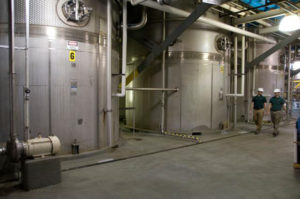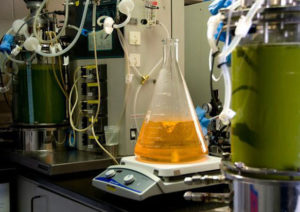New uses await

Algae are a diverse group of simple organisms that range from unicellular to multicellular forms, such as giant kelp. They are photosynthetic like plants, but their tissues are not organized into distinct organs like plants.
The largest and most complex algae forms are seaweeds. Microalgae refer to the numerous microscopic algae that grow in marine or freshwater. They are primary producers in the oceans that convert water and carbon dioxide to biomass and oxygen in the presence of sunlight. Microalgae are currently being utilized in a variety of applications, including nutrition and biofuel production.
Uses
The use of microalgae dates back 2,000 years, when they became a source of food during a famine in China. Other microalgae species were a common food source in Chad and Mexico as far back as the 16th century. In 1890, Chlorella vulgaris became the first pure culture of algae grown. In the 1950s, research started on microalgae as a source of food and medicine for humans. The research started in Japan utilizing c species.
The first industrial production utilizing a photobioreactor was constructed and run by IGV Ltd. in Germany to produce Chlorella as a nutritional supplement for poultry. Currently, heterotrophic microalgae are used in human and animal nutrition. One of the most successful of these products is the production of the long-chain, polyunsaturated fatty acid docosahexaenoic acid.
The potential uses for microalgae range from producing biofuels to reducing global hunger. Although a number of these uses may someday become reality, the fact is the commercial uses of algae are much fewer than the proposed uses.
About 30 percent of the world algae production is used for animal feed production, with the largest applications in aquaculture. Microalgae are required in larval nutrition, either fed directly in the case of mollusks and peneid shrimp, or indirectly as live prey food in small fish larvae.
Algae are marketed for use in human nutrition in the form of tablets, capsules and liquids. They are incorporated into pastas, snack foods, candy bars and beverages, as well. The commercial applications are dominated by four strains: Arthrospira, Chlorella, Dunaliella salina and Aphanizomenon flos-aquae.
Production
Large-scale production of algae started in the early 1960s in Japan with the cultivation of Chlorella. This was followed in the 1970s by the production of Arthrospira in Lake Texcoco in northwestern Mexico by Sosa Texcoco S.A. By 1980, 1,000 kg of algae were being produced by 46 factories in Asia.
In 1986, the use of Dunaliella salina to produce beta-carotene was established as a commercial venture at production facilities in Australia. Commercial facilities have also arisen in Israel, the United States and India, with current annual global production estimated at 10,000 mt.
The nutritional composition and biochemical diversity of microalgae have generated an enormous amount of interest in a variety of applications. Microalgae can have high protein content with an amino acid profile that provides essential amino acids. The lipid content can reach 70 percent, with a high concentration of omega 3 and omega 6 fatty acids. Microalgae can be a valuable source of vitamins and minerals, as well.
New microalgae products?

The great potential for microalgae resulted in Alltech purchasing a state-of-the-art algae facility with a fermentation capacity of over 1,000 m3 in September of 2010. One of the main focuses of the facility will be the development of products derived from microalgae.
“Algae fermentation presents our latest technological platform, from which we expect incredible opportunities in the areas of food, feed and fuel to arise,” Alltech founder and President Dr. Pearse Lyons said.
At least 800,000 different species of algae are thought to exist that have the ability to produce over 15,000 novel compounds. The enormous biodiversity within microalgae is largely untapped. Alltech‘s concept will be to develop a platform of products from algae that reflect those derived from yeast.
Yeast cells can be divided into multiple cell wall components and yeast extract that each provide a unique nutritional function. In addition, whole yeast cells in themselves provide a nutritional impact. Can a similar approach be used for microalgae?
The facility will allow continued work with Alltech’s carbon dioxide-sequestering microalgae strains, as well as strains grown with other carbon sources. The microalgae will then be used for value-added feed products, microalgae-derived biofuel and the production of ethanol.
Perspectives
Research has demonstrated that microalgae can be utilized as sources of proteins, lipids, vitamins and minerals, but other than specific applications in the growth of aquaculture species, algae are not widely used in animal nutrition. In order to utilize microalgae on a wider level, greater understanding of their nutritional value is required.
What new nutritional components within algae will become available? Can microalgae influence the immune systems or improve the antioxidant status of animals, or reduce stress and improve feed conversion? These are some of the areas that need to be researched in order to take advantage of the potential benefits of microalgae.
(Editor’s Note: This article was originally published in the January/February 2012 print edition of the Global Aquaculture Advocate.)
Author
-
Keith Filer, Ph.D., M.S.
Research Manager
Asia Pacific Biosciences Center
Project Manager for Aquaculture Research
Alltech
3031 Catnip Hill Pike
Nicholasvile, Kentucky 40356 USA[109,111,99,46,104,99,101,116,108,108,97,64,114,101,108,105,102,107]
Tagged With
Related Posts

Intelligence
A land grab for salmon (and shrimp) in upstate New York
The operators of Hudson Valley Fish Farm see their inland locale as a pilot to prove that land-based fish farming, located in close proximity to major metropolitan markets, can be successful.

Aquafeeds
A new nutrient for aquaculture, from microbes that consume carbon waste
Biotechnology firm NovoNutrients aims to produce a line of nutraceutical aquafeed additives as well as a bulk feed ingredient that can supplement fishmeal. Its process includes feeding carbon dioxide from industrial gas to a “microbial consortium” starring hydrogen-oxidizing bacteria.

Health & Welfare
A study of Zoea-2 Syndrome in hatcheries in India, part 1
Indian shrimp hatcheries have experienced larval mortality in the zoea-2 stage, with molt deterioration and resulting in heavy mortality. Authors investigated the problem holistically.

Health & Welfare
A study of Zoea-2 Syndrome in hatcheries in India, part 2
Indian shrimp hatcheries have experienced larval mortality in the zoea-2 stage, with molt deterioration and resulting in heavy mortality. Authors considered biotic and abiotic factors. Part 2 describes results of their study.


